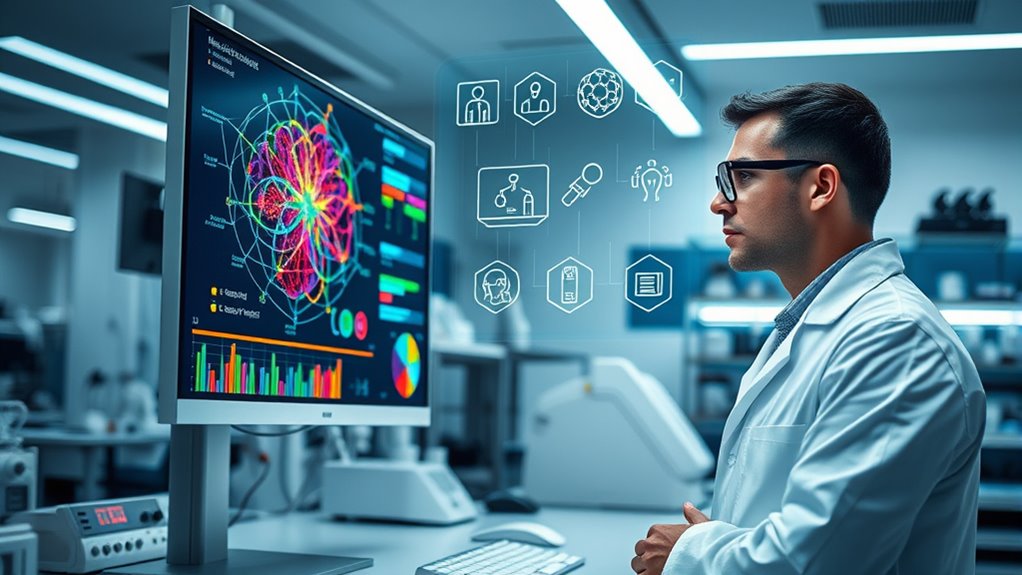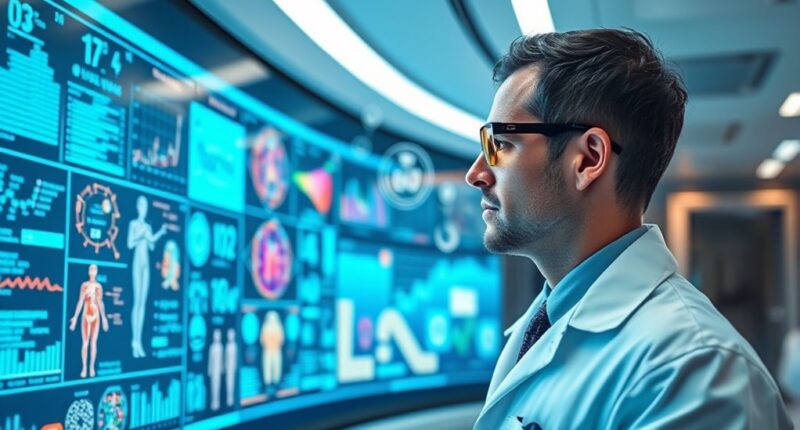A new AI model now evaluates the chances of over 1,000 illnesses, offering faster and more accurate diagnoses. It analyzes symptoms, medical history, and test results to identify potential diseases early, improving patient outcomes. AI systems in healthcare are already achieving about 86% accuracy, outperforming traditional methods. This advancement can help you get better care quickly, especially in underserved areas. Keep exploring to discover how this technology could transform your healthcare experience.
Key Takeaways
- Advanced AI models can evaluate over 1,000 diseases for diagnostic accuracy and risk assessment.
- These AI systems achieve accuracy rates of approximately 85.7%, enhancing early detection.
- Large Language Models (LLMs) interpret complex patient data to generate illness probability estimates.
- AI-based tools outperform traditional methods, reducing misdiagnoses and unnecessary interventions.
- Integration of AI improves healthcare accessibility, especially in underserved areas, for comprehensive disease assessment.

Artificial intelligence is transforming healthcare by enhancing the accuracy of illness diagnoses. With AI models now capable of evaluating over 1,000 diseases, you gain access to tools that can considerably improve diagnostic precision. For example, recent studies show that AI systems can reach diagnostic accuracy rates of around 85.7%, with sensitivity and specificity near 86% across large patient populations. This means that AI can reliably help identify diseases early, reducing misdiagnoses and enabling timely treatment. When clinicians review patient vignettes—descriptions of symptoms, history, physical exams, and lab results—AI assistance boosts diagnostic accuracy by approximately 4.4%. While the median accuracy for physicians using tools like ChatGPT Plus hovers around 76.3%, AI alone surpasses both traditional methods and human-assisted diagnoses in many cases. Recent advancements in AI accuracy have demonstrated the potential for these tools to significantly influence clinical decision-making. Artificial neural networks, a type of advanced AI, have demonstrated remarkable performance, particularly in predicting outcomes like mortality. These models can reach accuracy levels of 96.8% and specificity of 97.5%, outperforming traditional clinical scoring systems such as the Rockall score, which typically have accuracy around 53%. In detecting complex conditions like lymph node metastasis in colorectal cancer, AI models have achieved 100% sensitivity and 66% specificity, considerably outperforming existing guidelines from different regions. Such precision reduces unnecessary interventions, which are often above 85% when relying solely on guidelines, whereas AI-driven diagnostics can cut these unnecessary procedures to below 77%. This not only improves patient care but also reduces the risks and costs associated with unwarranted treatments. Large language models (LLMs) like ChatGPT process vast natural language data, enabling them to generate diagnostic suggestions based on detailed clinical information. When used alongside physicians, these models slightly improve diagnostic reasoning, with median scores increasing from 74 to 76. Although the improvement appears modest, the ability of LLMs to interpret complex clinical vignettes—integrating patient history, physical findings, and lab results—makes them invaluable for tackling complicated cases. To maximize benefits, physicians need formal training to navigate AI tools effectively, since AI alone may produce more accurate but less efficient diagnoses without human oversight. The integration of AI with clinical judgment is still evolving, but early results show a promising trajectory toward more precise, faster, and accessible healthcare. AI’s impact extends beyond accuracy; it democratizes healthcare by offering reliable diagnostics in underserved regions where specialists are scarce, and the potential for improving diagnostic precision ensures that more patients receive appropriate care. These models help standardize assessments, reducing variability caused by subjective human interpretation, and identify subtle disease patterns that might be missed otherwise. As the technology advances, collaboration among AI developers, clinicians, and ethicists is essential to ensure these tools remain effective, ethical, and culturally sensitive. Ultimately, the integration of AI into healthcare promises earlier interventions, better patient outcomes, and a step forward in making accurate diagnoses available to everyone, regardless of location or resources.
Frequently Asked Questions
How Accurate Is the AI Model Compared to Doctors’ Diagnoses?
You might find that AI models perform similarly to non-expert physicians, with about 52% accuracy, but they’re generally less accurate than expert doctors, who outperform AI by roughly 16%. In complex cases, AI like Microsoft’s orchestrator can diagnose correctly up to 85% of the time, sometimes surpassing experienced physicians. While AI helps speed up diagnosis and reduce errors, trusting it fully still requires careful validation and collaboration with medical professionals.
Can the AI Model Predict Rare or Emerging Illnesses?
Yes, the AI model can predict rare and emerging illnesses. It analyzes diverse datasets, like genetic, imaging, and clinical notes, to spot complex patterns. Even with limited data, techniques like transfer learning help improve accuracy. By integrating multiple sources, the AI can identify symptoms and risk factors for rare diseases, enabling earlier detection. While challenges remain, ongoing development aims to make these predictions more reliable and accessible for clinicians.
Is Patient Privacy Maintained During AI Assessments?
Yes, patient privacy is maintained during AI assessments, but only if strict safeguards are in place. You need to guarantee data is anonymized and protected through encryption and access controls. HIPAA compliance requires transparency about AI use and patient consent. By following these measures, you help prevent unauthorized disclosures and breaches, ensuring sensitive health information remains confidential while leveraging AI’s capabilities for improved healthcare outcomes.
How Often Is the AI Model Updated With New Data?
Updating the AI model is like tending a garden—it’s done periodically, not constantly. Usually, updates happen monthly or quarterly, depending on clinical needs and data flow. Some systems even refresh weekly or in real-time, but this requires significant resources. You need to balance staying current with avoiding overfitting, ensuring the model remains reliable and relevant without overwhelming your infrastructure or compromising safety.
Can the AI Model Replace Traditional Diagnostic Methods Entirely?
No, the AI model can’t replace traditional diagnostic methods entirely. You should see it as a helpful tool that complements your clinical judgment. It speeds up analysis, improves early detection, and reduces errors, but it doesn’t account for holistic factors like patient preferences or psychosocial aspects. Relying solely on AI ignores the nuanced, all-encompassing approach that experienced healthcare providers bring. Combining both ensures the best, safest patient care.
Conclusion
You might wonder if this AI model truly predicts over 1,000 illnesses accurately. While it shows promising potential, experts warn it shouldn’t replace professional diagnosis but serve as a helpful tool. The theory that AI can revolutionize healthcare holds some truth, yet it needs ongoing validation. Trust in technology grows as it complements doctors’ expertise, but always remember to consult healthcare professionals for personalized advice. AI’s future in medicine looks bright—if used wisely.









